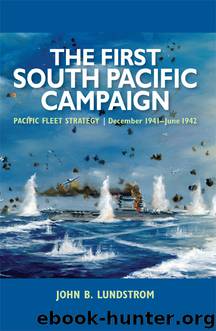The First South Pacific Campaign by John B. Lundstrom

Author:John B. Lundstrom [Lundstrom, John B.]
Language: eng
Format: epub
ISBN: 9781612513522
Publisher: Naval Institute Press
12
Withdrawal from the Coral Sea
Shaken by the loss of the Lexington, Task Force 17 continued south to regroup. On the morning of 9 May, a search plane from the Yorktown reported sighting a Japanese carrier task force 175 miles northwest of Task Force 17. Fletcher immediately prepared for a possible Japanese air strike. He resorted to flying one of his officers to Australia in order to arrange personally for an air strike on the target by AAF bombers. He also wanted to keep radio silence in order not to alert the enemy to his presence. For once Brett responded quickly. He despatched 14 Army bombers which reached the target area about the same time as a small strike force from the Yorktown. The target turned out to be a reef which had fooled the crew of the search plane because of its resemblance to the wakes of warships.106 That afternoon Fletcher received an important directive from CinCPac. Nimitz instructed him to return to Pearl Harbor or the West Coast with the Yorktown, the Lexington, and screening ships of the old Task Force 17. Kinkaid’s forces were to join Halsey when he arrived in the vicinity. As of yet, Nimitz did not know of the loss of the Lexington.107 The same day, Fletcher detached Crace from his command, bringing Task Force 44 back into existence. Crace had waited southeast of Port Moresby until he was sure that the Japanese were not coming, then retired to Brisbane to refuel.108 On 10 May Fletcher radioed his intention to stop at Tongatabu on the trip back and return to Pearl Harbor. At 1600 on 11 May, Fletcher detached Kinkaid with two heavy cruisers and three destroyers to proceed to Noumea. One heavy cruiser from Task Force 17 accompanied with orders to rejoin at Tongatabu.109
Admiral Nimitz informed Admiral King of the reasons behind his decision to withdraw Task Force 17 from the Coral Sea. He cited the fact that the Yorktown had sustained damage and could be more easily crippled or sunk in a future battle; besides her air group had only a small number of operational aircraft. He wanted the Lexington and the Yorktown to go directly to the West Coast if the ships needed extensive repairs which Pearl Harbor was not equipped to service.110 Unaware of the sinking of the Lexington when he made his decision, Nimitz learned of it during the late hours of 8 May (Hawaiian time). On 9 May CinCPac staff reviewed the previous day’s decision and concurred with it. Although it might have appeared desirable to retain the Yorktown in the Coral Sea to serve with Halsey’s Task Force 16 for one operation, Nimitz decided against this. By this time he realized that the Japanese had postponed the MO Operation and had only a fleet carrier, the Zuikaku, and supposedly the converted carrier Kasuga Maru in the Rabaul area. He knew that Task Force 16 could handle them easily. In addition, Nimitz wanted to have the Yorktown repaired as quickly as possible because of possible enemy intentions in the Central or North Pacific Areas.
Download
This site does not store any files on its server. We only index and link to content provided by other sites. Please contact the content providers to delete copyright contents if any and email us, we'll remove relevant links or contents immediately.
| Africa | Americas |
| Arctic & Antarctica | Asia |
| Australia & Oceania | Europe |
| Middle East | Russia |
| United States | World |
| Ancient Civilizations | Military |
| Historical Study & Educational Resources |
Flight by Elephant(1509)
The Rise and Fall of the Third Reich: A History of Nazi Germany by William L. Shirer(1389)
Unbroken: A World War II Story of Survival, Resilience, and Redemption by Hillenbrand Laura(1124)
German submarine U-1105 'Black Panther' by Aaron Stephan Hamilton(1032)
Last Hope Island by Lynne Olson(942)
A Bridge Too Far by Cornelius Ryan(935)
War by Unknown(932)
The Victors - Eisenhower and His Boys The Men of World War II by Stephen E. Ambrose(907)
Rogue Heroes: The History of the SAS, Britain's Secret Special Forces Unit That Sabotaged the Nazis and Changed the Nature of War by Ben Macintyre(895)
The Guns at Last Light: The War in Western Europe, 1944-1945 by Rick Atkinson(894)
0060740124.(F4) by Robert W. Walker(876)
The Hitler Options: Alternate Decisions of World War II by Kenneth Macksey(873)
The Railway Man by Eric Lomax(852)
All the Gallant Men by Donald Stratton(823)
Hitler's Vikings by Jonathan Trigg(818)
A Tragedy of Democracy by Greg Robinson(811)
The Battle of Berlin 1945 by Tony Le Tissier(811)
Churchill's Secret War by Madhusree Mukerjee(808)
Hitler's Armies by Chris McNab(788)
